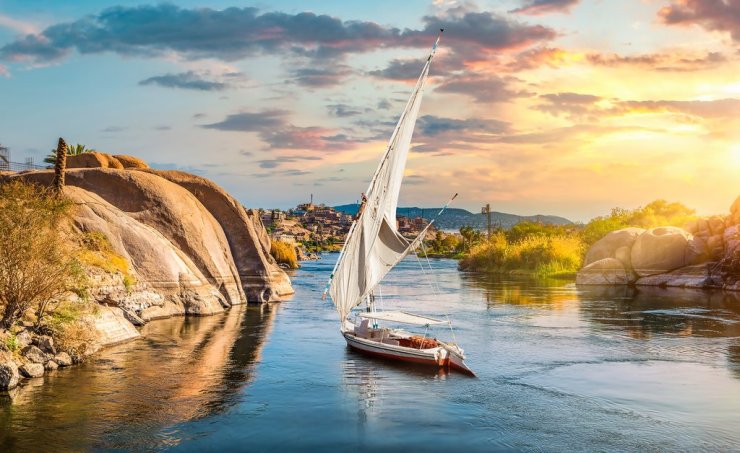
“The Nile, forever new and old,
Among the living and the dead,
Its mighty, mystic steam has rolled.”
Henry Wadsworth Longfellow
Courtesy of Samuel Magal:
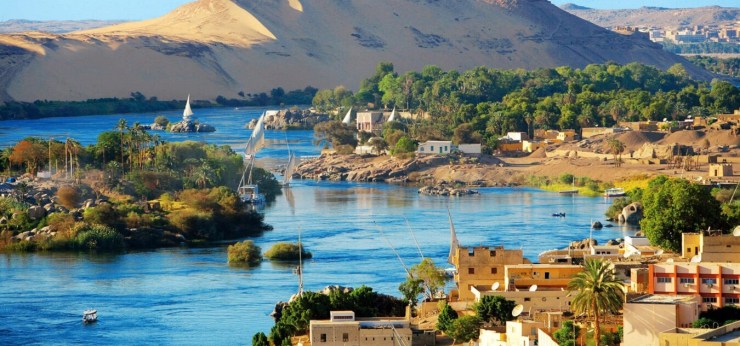
“How doth the little crocodile
Improve his shining tail,
And pour the waters of the Nile
On every golden scale!
How cheerfully he seems to grin,
How neatly he spreads his claws,
And welcomes little fishes in,
With gently smiling jaws!”
Lewis Carroll
Courtesy of Jerlan Zuniga:
Courtesy of mycompasstv:
It is something of a surprise that experts differ strangely as to which is the longest river in the world. The Times Atlas favours the Amazon, the Encyclopedia Britannica says it is the Nile, while the Guinness Book of Records isn’t sure.
Atlas Pro tackles this thorny question at length!
As it is, one thing is certain; the importance of the Amazon in the human scheme is slight, that of the Nile is huge. The one, however grand, has no history, enriches no land, and supports a handful of fishermen. The other is currently responsible for the existence of over 99 million people, and even in the time of the pharaohs may have supported a population half that size, which ruling out China, would probably have exceeded the number of inhabitants of the rest of the globe.
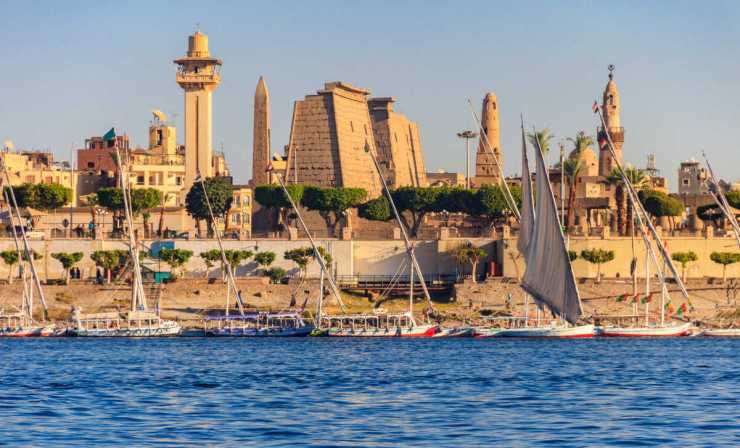
“The Nile River” by Brandon Fiechter (courtesy of Brandon Fiechter’s Music):

The Nile brought magnificent civilisation into being, wholly dependent upon the annual bounty of its floods, and a single year’s withholding of its waters from the parched lands awaiting them would be enough to destroy the empire. ‘Egypt’, said Herodotus, ‘is the gift of the Nile.’
The River Nile in Ancient Egypt (courtesy of History Hub YTTV):
And not only Egypt but that 3,000-mile-long ribbon of fertility which uncoils through the desert of Sudan, where local wars have been fought when an occasional drop of a few inches in water levels meant that there was not enough food for all.
Below the city of Khartoum.
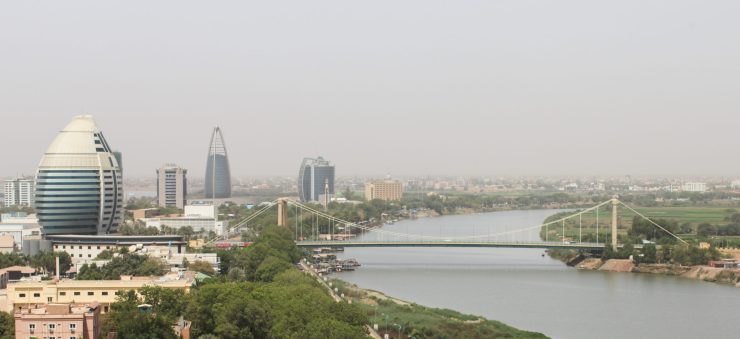
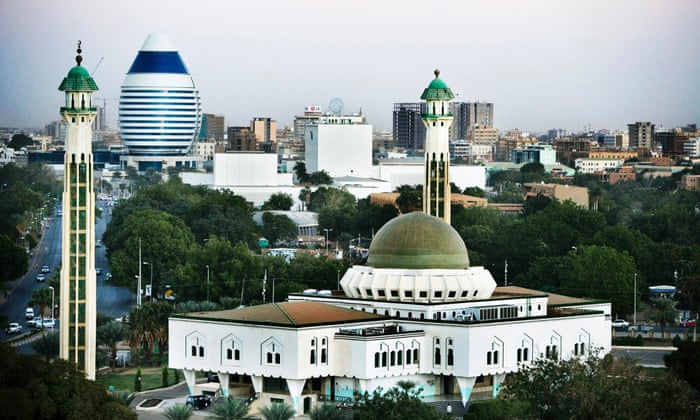
Courtesy of Aziz Shiddo:
Khartoum, the capital of Sudan, is a good place to start the exploration of the Upper Nile. The most repellent sights of this city are the main-street shops full of the horrid ornaments carved from the tusks of the thousands of elephants killed for them. There are also the skins of such endangered animals as leopards, cheetahs, and crocodiles offered at bargain prices. And in ironic contrast, people exchange courtesies with others:
‘Peace on you.’ ‘And on you peace and the blessings of God.’ All these blessings but none to fellow creatures, animals. Quite shameful. A beggar sitting close to the shops advertised his plight by a strong-voiced cry, ‘God is merciful,’ repeated with unflagging conviction every ten seconds throughout daylight hours. According to a printed warning, it is strictly forbidden to photograph him, or any other ‘debasing sight.’

Below is the African Leopard.
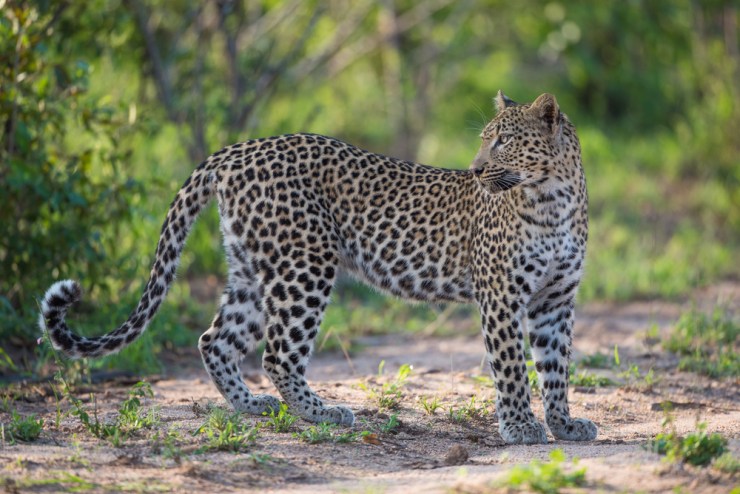
A family of Cheetahs:
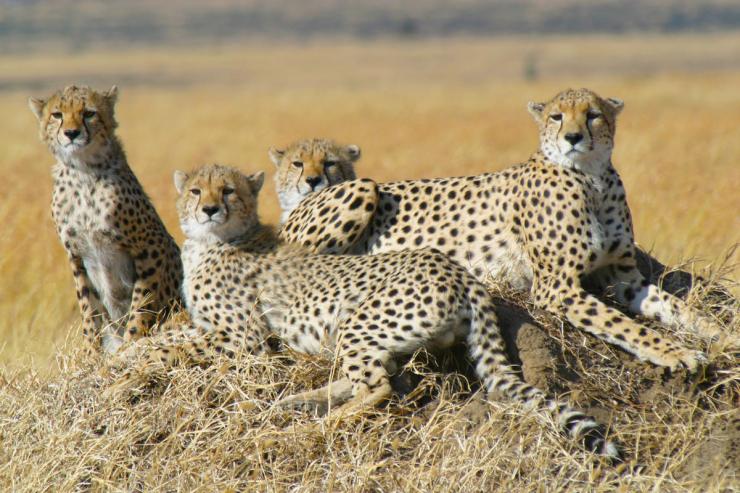
The friendly welcoming grin of the Nile Crocodile:

The Nile Crocodile in action (courtesy of Wild Tomorrow Fund):
By way of an interesting aside, have you ever wondered what would happen in a crocodile’s mind if it were to listen to some of the music of the great composer J.S. Bach? (courtesy of Get News):
“Brandenburg Concerto No.4” by Johann Sebastian Bach (courtesy of Bristol Ensemble Live):
Khartoum is built at the confluence of the Blue and White Niles, the first gathering its water in the Ethiopian Plateau; the most distant source of the second being the Kagera River in Burundi, some 1,500 miles to the south. It comes as a surprise to find that one river is actually blue, and the other, not quite white but paleish grey. To most travellers it is an emotional experience to discover a spot on the sand-banks where this separation of colours is clearly visible.
Courtesy of Gazetica Explorer:
At Abu Rof, just outside the town limits, people strip off to wash down, having pushed their way down to the water through the herds of cows and goats that are brought to drink. Here taxi drivers back their shattered Toyotas into the shallows to sponge off dust, and here the donkey-drawn municipal water carts are brought to be filled. This is a playground to which men bred in deserts are attracted by the mere presence of water. They sit here in rows in barbers’ chairs to have their heads shaved and before the lathering begins the barber adjusts the mirror to enable his customer to enjoy the reflected scene of all that is happening down by the river at his back.

Abu Rof fosters intense sociability. Neighbours carry out their beds to sleep on the beach, which is furnished like a communal room with domestic objects, chairs, the occasional sofa, kitchen stove, most decorated by pigeon droppings. The villagers swap tall stories, pray a little, brew up tea, and play a game of marbles. On Friday evening, when all Khartoum relaxes, it is the time to see the dervishes whirl. About 100 of them march in under their flags and engage in a preliminary workout. The drums crash and the dervishes began to jerk and twitch. Any bystander could join in and many do. The drums impose their own tremendous rhythmic discipline, but within this framework, anything goes. One pranced about, leaped, galloped, whirled, howled, shrieked, frothed at the mouth if possible, while the dervishes cracked their whips and lashed out their canes. It was a good, therapeutic mania, similar to our Strictly Come Dancing, with ten marks out of ten for the contestant who could throw a trance or work themselves up into a fit. A note to travellers – obviously, it is an experience not to be missed.
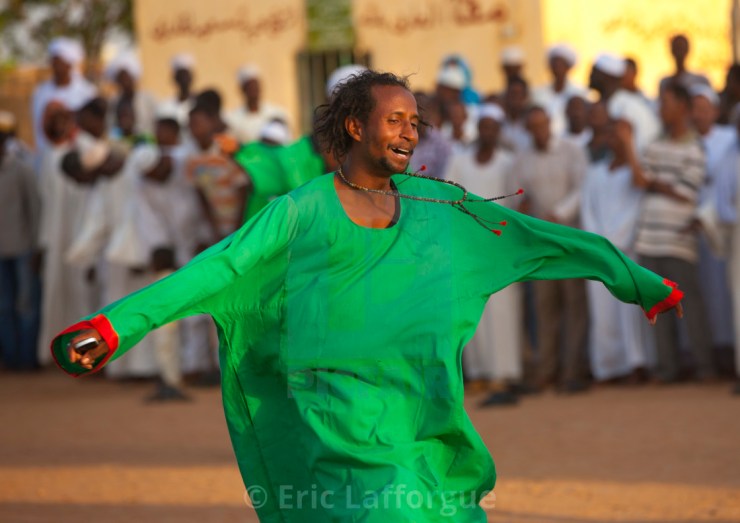

Courtesy of Yoho Media:
The Nile is rarely easy to approach. In the Sudan river steamers only operate along about a quarter of its length, and roads following the valley are usually out of sight of water. The dam built in 1934 is covered by the great names of British engineering of those far-off colonial times. Here fishermen, casting their nets under the watchful eyes of herons and fishing eagles, are taking Nile perch from the water, to barter with the villagers for such things as firewood and eggs.


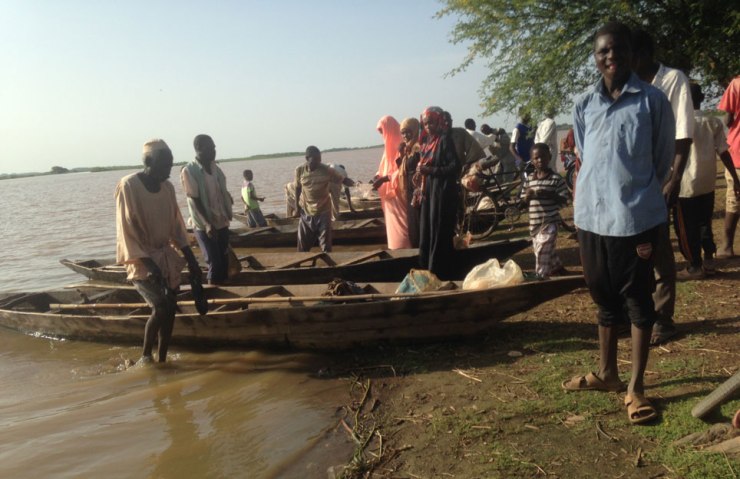

Some villages, just beyond the reach of the Nile floods, are so poor that even the vultures have given up on them. Nothing, absolutely nothing is ever thrown away. The rains come in autumn, the villages grow a single crop of sorghum, and after that their lives teeter on the edge of survival for the nine months to the next rain. A tourist who stopped for a snack outside one of the villages wrote: ‘I made a move to gather my litter. My driver was horrified. ‘Leave everything, the goats will deal with the orange skins, even the paper, and the beer-cans will be turned into cups by the villagers. Come back here in an hour, and you won’t see a trace of anything.’ Since the vultures had lost hope and gone away, animals that had died from natural causes lay scattered about these villages quite intact, but mummified by the sun.’

Moving ahead on the Nile becomes a soft bedazzlement of green fields moated with running water, and sparked with many, many birds; great wading storks in absurd postures, ten kinds of kingfisher, green cuckoos, and crimson bee-eaters, insect hunting from the telegraph poles where they perch in their hundreds. The Nile valley, throughout the length of its passage through the arid lands, is paradise for birds, drawn to its water and the teeming insect life of its marshes and its saturated earth.
Yellow-billed Stork at Abu Simbel:

Northern Carmine Bee-eater, south of Khartoum on the Blue Nile:


Courtesy of Smithsonial Channel:
Courtesy of Nat Geo Wild:
The management of water on this scale is a complex affair and technological breakdowns are compounded by a brain-drain to the affluent Gulf States. Water levels are maintained by specialists at pumping stations and irrigation regulators, who are required to be in constant touch with one another through the telephone network. This has begun to break down, so that canals frequently overflow and land is damaged by excessive flooding. It is said too that the canals are no longer kept as free from weeds as they should be. This not only reduces the efficiency of irrigation, but has provoked a marked increase in the sickness of children.

It is the sixth cataract where the Nile slips between burnished coppery hills and miniature gorges. The description cataract over-dramatises a fall in the water, rippling over pink stones hardly more than a few feet high. This is the place where the boats taking part in Kitchener’s river war had to be dismantled once again to be reassembled only a few yards further on (nuts and bolts replaced rivets in their construction), and there is a local legend that here they were bombarded by Mahdists who remained miraculously immune from the British guns by reinforcing the chainmail they wore with pages from the Koran. Above the babble of the cataract, there are wide tranquil waters with palms, beanfields, and many butterflies.

Below is a view of Shendi in North Sudan.

Shendi is one of the crossroads of Africa that always lived off the river traffic and the caravan routes crossing the Nile at this point. It had been an emporium of ivory and slaves. A hard day’s drive will bring a traveller to the ancient kingdom of Meroe where there are about 200 low pyramids clustered in groups over the low hills. They remain so well preserved, so clean-cut in their outlines that one can see that so many have lost their tops, dismantled in search of treasure by an early Egyptian military expedition tricked by an impostor into coming here in search of gold.
Courtesy of Tatouf al Mzungu:

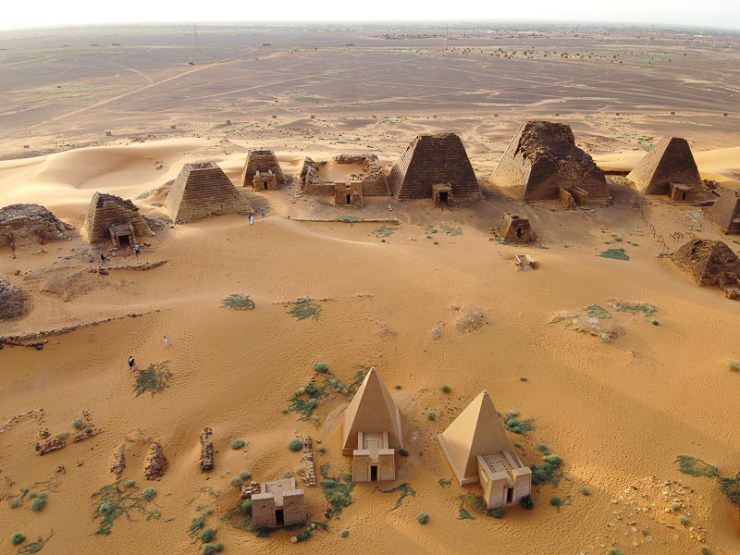

“The Mausoleum at Halicarnassus” from the “Seven Wonders Suite for Orchestra” by Stuart Mitchell, performed by the Prague Symphony Orchestra (courtesy of Stuart Mitchell Music):
Below is Lake Nasser.


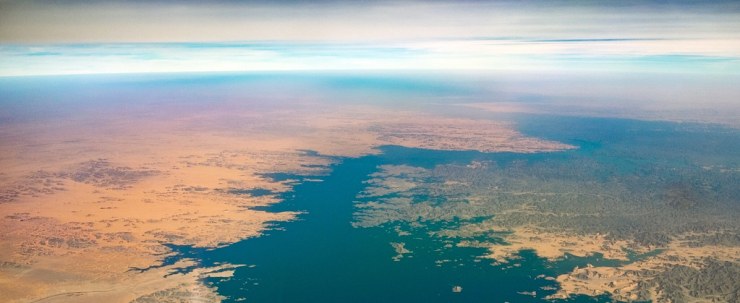
The Aswan High Dam created the 300-mile-long lake, Lake Nasser, that is a surprise. It looks like an immense version of a Highland reservoir, and this great sprawl of water has everything – even fjords – all of them alien and out of place in this dry and incandescent land. Egyptians say that the dam turned out to be a mixed blessing. The thirst for industrialisation, cost what may, has been satisfied by the dam and the electricity it has generated, but some of the factories built are disappointing, like the one that was producing many millions of headless pins. The question is whether in the long term Egypt’s future is at risk.
The natural rhythms based for thousands of years on the annual flooding of the Nile and the soil renewal by the silt deposited by the floods have been disrupted by the dam. Artificial fertilisers, expensively produced, will be required as a substitute for the silt, but the perennial irrigation – which replaces the annual flooding, and drying off – has need of an expensive system of deep drains, which Egypt cannot afford. The loss of silt has accelerated the Nile’s flow, eroding the banks and threatening to undermine the bridges. The many fish that once came down from the upper reaches of the Nile are now held back by the dam.
Courtesy of Lake Nasser Adventures:
Below is the Egyptian port city of Damietta.
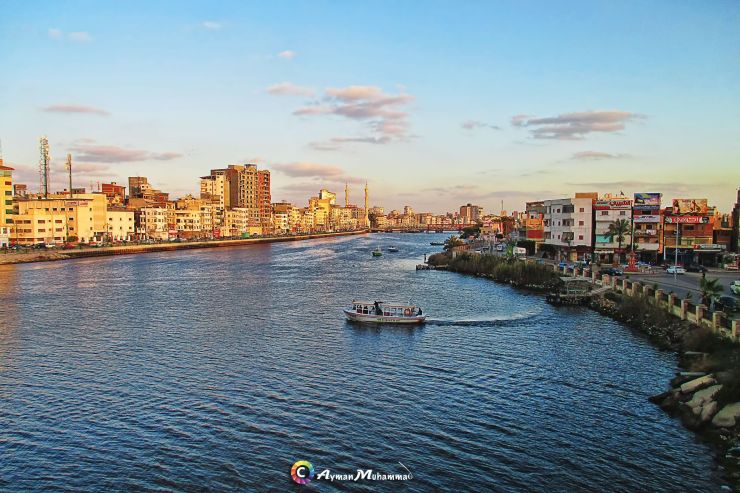
North of Cairo the Nile divides into two channels, one reaching the sea at Rashid, near Alexandria, and the other at Damietta, about forty miles from Port Said. From these two main courses spreads the vast fan of the Delta, the vegetable garden which is in its own way a secret place, hardly visited by anyone without business there. The Delta is beautiful in all its parts. A soft light billows over the fields and the peasants work with their buffaloes, and the little boys delve for catfish in the mud.




“The Hippopotamus Song (Mud, Glorious Mud)” by Flanders & Swann (courtesy of Richard Seel):
For much of the estimated forty million years of its life, the Nile has been depositing silt in the Delta. This jet-black, crumbling, crystalline, almost vivacious substance bears no resemblance whatever to the soil tilled by the British gardener. The vegetables that are grown there are huge. The Delta population doubles every two years. The use of the Pill is rejected by the very poor. Children here are a source of income, and as they undercut the price of adult labour, they can find employment, however short work may be.
The amazing fertility of the Nile (courtesy of BBC Earth):
Below are volunteers clearing plastic from the River Nile.
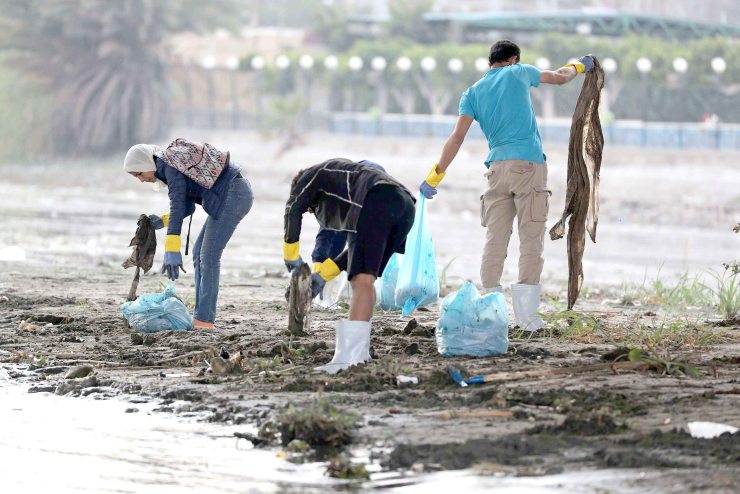

The biggest problem the Nile is facing now is horrendous plastic pollution. If possible, everyone should watch the documentary programme ‘The Plastic Nile’, which is available to view on-line in full.
Trailer for ‘The Plastic Nile’ (courtesy of Sky News):
Reporter Alex Crawford wrote: ‘The Nile has long been called the cradle of civilization. Today, thousands of years after the pyramids were built along it, the river is still the life spring for millions. But for how long?’ Her documentary revealed that the Nile has reached a crisis point with a devastating impact potentially around the globe. ‘Every year the Nile dumps 80,000 tonnes of plastic into the Mediterranean, and that affects our future.’ wrote Alex. ‘It is an environmental catastrophe. … Some waterways were so clogged up, you couldn’t see there was water underneath.’ When finally Alex reached the point where the Nile runs into the sea, she could see that there was plastic everywhere. ‘We in the West think we’re doing our bit, but we need to see the bigger picture. We need international collaboration, urgently. People need to realise what’s going on.’
The Nile will die if nothing is done now.

Courtesy of Terra Mater:
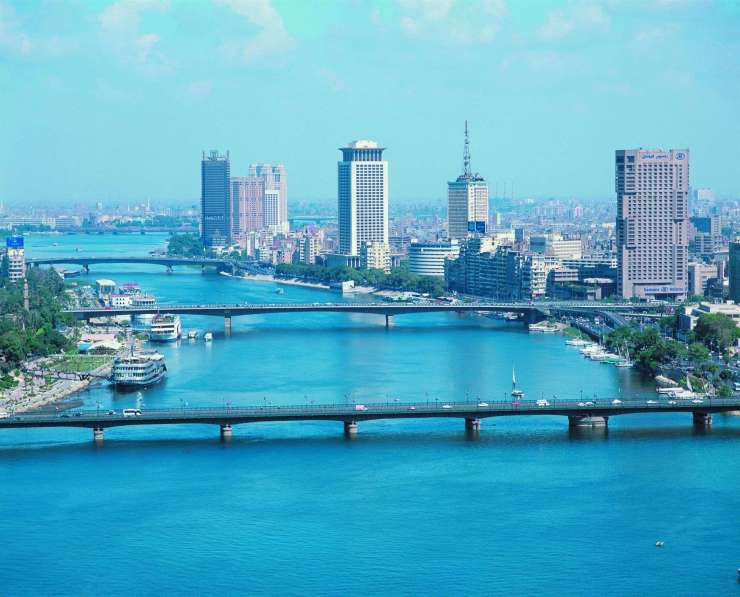
The beauty of Africa, from Cape Town to Cairo (courtesy of SkyPacking):
Thank you again, Arun. Greatly appreciated.
Joanna
LikeLike
Joanna
Please read my latest blog on Chandagyo Upanishad 6th chapter
https://arunsingha.in/2022/01/08/essence-of-chandogya-upanishad-part-6c-of-6end-of-6th-chapter/
Please find time to read and forward.
Regards 🙏🙏
LikeLike
You are always welcome Joanna.
Stay blessed always 😊🙏
LikeLike
I understand that.
I have read your post on Jam Raja
Emperor of Jamnagar
Popularly known as Jaan Saheeb, who helped polish women and children from Russia during world war. That post was written with full dedication.
I know how much you love India.
I am proud of you.
Best wishes 😊🙏
LikeLike
You are always welcome.
Stay blessed always 😊🙏
LikeLike
🙏😊
LikeLike
😊🙏
LikeLike
Thank you!!
LikeLike
Thank you so much, Arun!
LikeLike
I will do!!
LikeLike
Thank you so much.😌🙏
LikeLike
😊🙏
LikeLike
🙏
LikeLike
Thank you, Arun!
LikeLiked by 1 person
Thank you!!
LikeLiked by 1 person
Thank you so much Jo 🙏❤️😍 for another great journey, new knowledge, beautiful photos and movies, nice music 😍 I feel sorry for animals and this plastic everywhere, in Poland we also have a lot of it …
People’s awareness is growing, but as you can see still not enough …
I hope that Google explains well, my son is not at home, as you know, unfortunately not I know English, but I wanted to write to you right away 😊 Regards, Jo ❤️
LikeLiked by 2 people
Thank you, Jo, for your wonderful comments! Your English is good enough to make me happy that you liked my post! I do hope that you continue to read my posts with Google or without it; I left a message on your blog after reading about Chopra.
Joanna
LikeLiked by 1 person
Thank you again, Jo. Greatly appreciated.
Joanna
LikeLiked by 1 person
Yes Jo, I will be happy to read your posts 😊 I saw your wonderful comment and wrote back, hope you got the reply. And thank you again 🙏❤️😍 Jo
LikeLike
🙏❤️😍❤️😊
LikeLike
Thank you, Jo!!
LikeLiked by 1 person
Wonderful and interesting post, Joanna!
The way you’ve not left anything and explained everything, with vedios and pictures.
LikeLiked by 2 people
Thank you, Maria, for your kind comments!
Joanna
LikeLiked by 1 person
Thank you again, Maria. Greatly appreciated.
Joanna
LikeLike
Always Welcome Joanna!
LikeLike
Actually, it is naturetails.blog
LikeLiked by 1 person
Yes! Noted. Thank you! Regards.😊🙏
LikeLike
An extremely thorough, and educational post. Photos bring it all to life. I went on Nile cruise year ago and it was amazing, I really loved it. Your post brought back a lot of memories and the history. Beautifully written.
LikeLiked by 2 people
Thank you very much for your wonderful comments! I am very happy that my post resonated so well with your experience of traveling on the Nile! It would be lovely if you could tell me your name, please.
Joanna
LikeLiked by 1 person
Thank you again. Greatly appreciated.
Joanna
LikeLike
bella
LikeLike
Thank you very much!
LikeLiked by 1 person
Nice, Great info! Thanks for sharing…
LikeLiked by 1 person
Thank you for your comment.
Joanna
LikeLiked by 1 person
My Pleasure….
LikeLike
Thank you.
Joanna
LikeLiked by 1 person
Beautiful pictures and good information
LikeLiked by 1 person
Thank you for your kind comment.
Joanna
LikeLike
Stunning post Joanna💕🌸 Thank you for an amazing share!
LikeLiked by 2 people
Thank you, Henrietta, for your wonderful comment! You might like my today’s post about the Congo River!
Joanna
LikeLiked by 1 person
Thank you again, Henrietta. Greatly appreciated.
Joanna
LikeLiked by 1 person
Very nice write
LikeLiked by 1 person
Beautiful post. Loved the facts, snaps, video, and music.
LikeLiked by 1 person
Thank you, Trishikh, for your wonderful comments! Greatly appreciated. If you can/or have time look up my The Great Scientific Discoveries, we write about the similar things. Also, the first post in my The Greatest Books series I wrote about Tagore whom I loved from my childhood. Remember his remarkable poem “my heart touches your feet”?
Joanna
LikeLiked by 1 person
I will certainly check it out.
LikeLike
Thank you!
Joanna
LikeLiked by 1 person
Thank you! Greatly appreciated.
Joanna
LikeLiked by 1 person
You put so much work into your blogs–truly works of art.
LikeLiked by 1 person
Thank you for your wonderful comment! Greatly appreciated!
Joanna
LikeLike